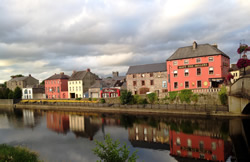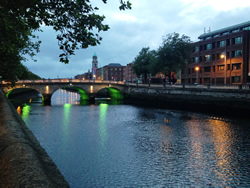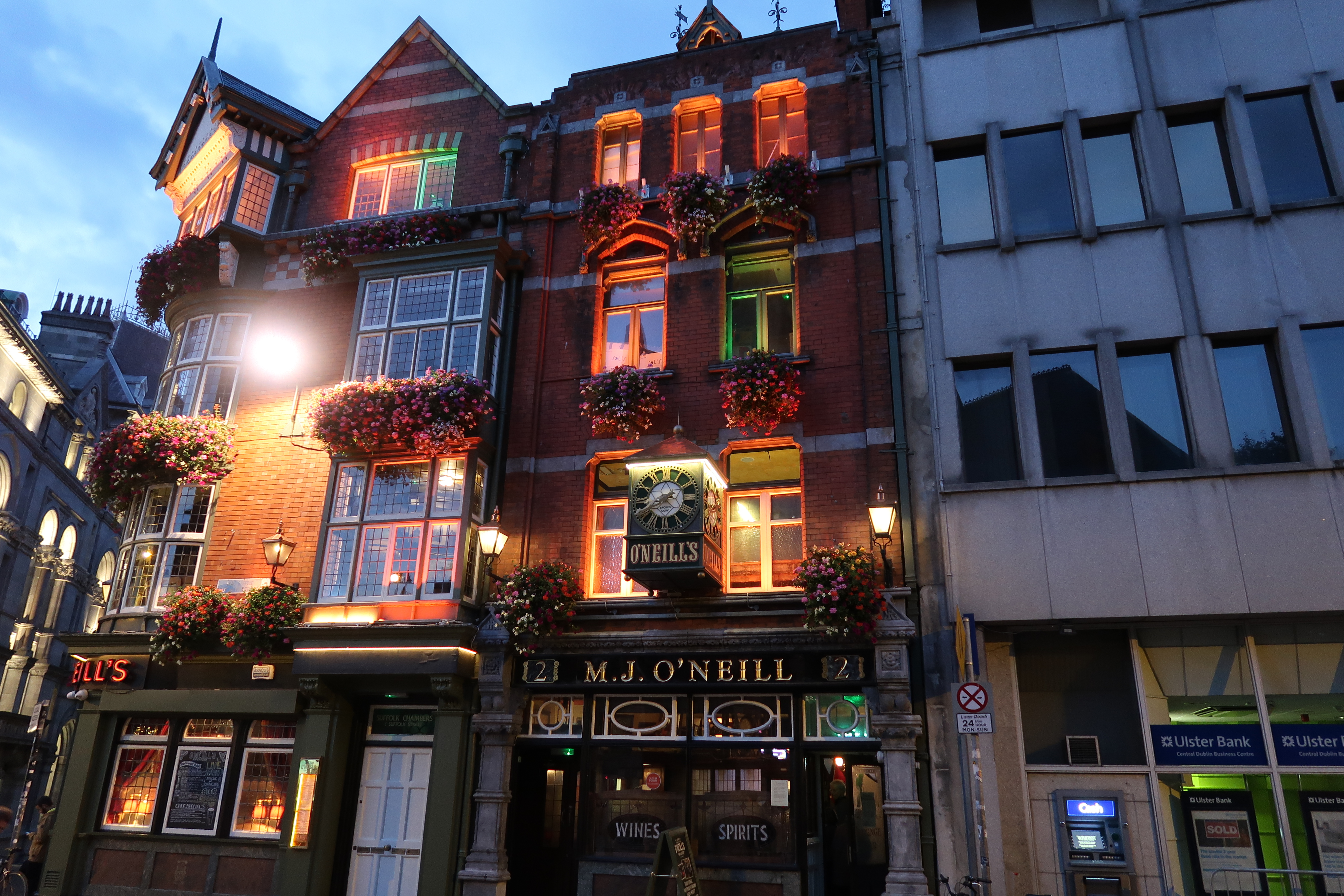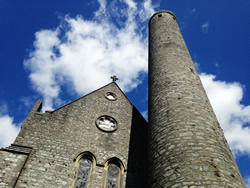Drinking to life: Rebels, death and beauty in the Irish Republic
by Scott Thomas Anderson
The Sacramento News & Review

William Butler Yeats called it “the Celtic Twilight,” a push to save Ireland’s wandering hearthside storytellers of the past — those oracles who could cast spells of the imagination using the beauty of misty hills and a long history of hardship that hasn’t been forgotten: Yeats coined the term “Celtic Twilight” 20 years before the last battle for Irish Independence would evolve those traditions into every part of the nation’s artistry, giving the Emerald Isle some of the most memorable musicians, writers and playwrights the 20th Century’s ever encountered.
Today, many of its storytellers still carry a sadness that charges their humor because the past haunts Ireland’s landscapes and creative achievements. Yet, visitors here may find that the future seems even more alive – especially in the peoples’ energetic, unapologetic, slightly tipsy celebration of life.
In Search of Real Dubliners
The first time I saw musicians Eddie Valentine and Brendan Lynch they were facing the crowd from a low stage at Fitzsimons pub, light faintly cascading from their shoulders to blood-red bricks and old wood barrels on the floor. Behind the duo, a window looked out to the bustling streets of Dublin’s Temple Bar neighborhood; and beyond, dusk settled on the River Liffey, pulling shadows down faded Georgian building fronts that James Joyce once ventured by at sunset.
Valentine and Lynch began to perform a slow, wrenching ballad called “In the Rare Old Times.” Picking luminous notes on his acoustic guitar, Valentine summoned a chiming earthiness in his voice to sing out, “And the years have made me bitter / The gargle dims mee brain / Cause Dublin keeps on changing / And nothing seems the same.” Lynch’s fiddle followed along, its searing seesaw delicately crying against the melody – a sad, second voice of sweetness that went razor-whistling between the words and arpeggios. The song ended with a warm applause around the pub.

Photo by Scott Thomas Anderson
“Is anyone celebrating something tonight,” Lynch asked with his fiddle near his chin. Two young ladies from the U.S. started laughing. “You’re celebrating something?” Lynch quipped. The giggling persisted as the two looked up at the stage. “What are you celebrating?” The fiddler went on. The girls shrugged between their hiccupped cackling. Lynch raised his eyebrows. “Being alive?” he asked. The women blearily nodded. Holding the neck of his fiddle in one hand, Lynch lifted a pint of Guinness from a stool to assure them, “Well, I’ll drink to that.”
Soon, the two musicians launched into Ireland’s most popular drinking anthem. Patrons quickly hoisted their heads and pints up, recognizing the reckless, double-stepping rhythm and drummed strumming that musters the chant, “Musha rain dum a doo, dum a da / Whack for my daddy, oh – whack for my daddy, oh / There’s whiskey in the jar!”
“Of course, we spell whisky a little differently here in Ireland,” Lynch told the audience. “We spell it with an ‘e.’ And if some of you are here for a few days, you might want to walk over to the Jamison Distillery. You just head down the street here, make a right at all of the drug addicts, and then turn left at the homeless shelter, and it’s up the way by a pub called the Cobblestone, which is alright at night, if it’s dark enough.”
A shot of Irish humor? Some ironic Gaelic honesty? Both ingredients are essential to the culture’s “Craic,” or connective conversation; and Lynch’s remark hinted at Dublin’s conundrum of double-appearances that are so prevalent in the Temple Bar district. While Fitzsimmons still hires Trad dancers and musicians like Lynch and Valentine, the tourists-swamped Temple Bar area is a Joycean mirage of Irish parody. At a glance, it appears as the Dublin the world often pictures – a clutter of ornate green, yellow and red pub-fronts traced in bronze and doused in lush, hanging flowers. But like New Orleans’ infamous Bourbon Street, Dublin’s Temple Bar is an over-hyped, overcrowded labyrinth of wasted partiers and automated arrivies typically more interested in post-vacation name-dropping than discovering the city’s real essence.
From the Rugged West to the Seditious SouthIt’s been said the true magnetism of Ireland lies in its west, near the seaside cliffs at the far end of the Gaelic world: This is where, above the town of Dingle, you find the Republic’s own rolling, wondrous shadowlands.
Conor Pass rises over a splashing hill-scape of grass and slivered waterfalls – a swaying spine that gently dips under pearly clouds and dimpled, sheep-dotted falls in the terrain. Every side of the pass is calicoed in light and shade, brushed by passing clouds overhead that change the land from grey to spring-touched green.
Driving west, travelers come into Dingle Town. This narrow, pub-cluttered port opens on views of horse riders clanking along muddy mountain paths above, or taking their steeds across quiet beaches below, sometimes even leading the horses mane-deep into the ocean. Dingle’s signs are written in Gaelic, and its history is spelled out in crumbling stone monk domes and empty, thatch-roofed “famine houses.” Dingle is a surviving piece of the remote, rural epoc whose imaginative “peasantry” inspired Yeats to write that, “Hope and Memory have one daughter and her name is Art.” And art is thriving here, with the best Trad musicians in all of Ireland performing at the pubs, especially O’Flaherty’s, O’Sullivan’s Court House or the Gaelic-named An Droichead Beag.
Dingle’s sea captains will take visitors out whale-watching and dolphin-chatting, while sunrise offers a sky-lit drive along the coast of County Kerry, watching the lifted, grass-glazed cliffs get hit by crashing waves of white and piercing blue.
Just 150 kilometers south of Dingle’s coastline is the landmark town of Kinsale. It is a tucked-away harbor that’s the jewel of County Cork, infamously known throughout Ireland as “the Rebel County.” From the Irish-supported Spanish Armada landing of 1601, to Irish Republican Brotherhood retaliations of the 1920s, Kinsale and County Cork have been proverbial hotbeds of insurgent fighting against the English. The region gave birth to the gun-toting revolutionist Michael Collins, and it’s also where, near Bealnamblath, Collins went down in a hail of hotly exchanged bullets in 1922.
Today, the most fiery thing about Kinsale involves the creativity of its master seafood chefs. Restaurants from Fishy Fishy to Crackpots are big draws in town, but it’s only though immersing one’s self in the soulful singing and inebriation of Kinsale’s pubs that the place really sinks into the blood. The town’s nightlife also clings to that controversial genre of music known as Irish Rebel songs. Beyond contemplating whiskey, death and immigration, the nation’s ballads tend to confront its many tragic struggles around independence. Hearing anyone in a Kinsale put belt out “James Connolly,” “The Foggy Dew” or “Come Out Ye Black and Tans” is enough to stir that sense of the so-called “fightin’ Irish.”
One place you might hear those songs is Kitty O Se’s pub. With its ballooning Irish flag puffing down and vintage boat oars mounted on darkly aged stone, Kitty O Se’s is its own jovial long hall where it’s not uncommon to see men in sailor hats grab women off the barstools and pull them into a jig on the floor. It’s the kind of room that sometimes erupts into loud, Gaelic sing-alongs with the karaoke machine, offering a feeling of togetherness like few others.
‘Rovin’ through Kilkenny’
Kilkenny. Ireland’s Little Edinburgh. Part medieval doorway, part Hibernian arts center, this bantam destination is an energetic crossroads brought to life by portrait galleries, manicured gardens and almost as many coffee houses as beer-soaked pubs. The River Nore flows through the heart of Kilkenny, adding to the mystique of a castle towering over it, as well as the town’s north hill that lifts up to a moss-laden, Celtic cemetery.
Guests come to Kilkenny for its spectrum of timelessness. They come to see its poetic fountains and arboretums under blue skies. They come to wander its 700 year-old cathedral, where Bishop Richard de Ledrede held one of Ireland’s first witch trails in the 12th Century. They come to drink in the Kyteler Inn, with its cold, rain-beaten walls dating back to that same witch trail – its stones directly connected to the burning of a woman named Petronilla, at the stake, in 1324.

“round towers.”
Beyond Kilkenny’s sights are the people, those careless conversationalists often smoking hand-rolled cigarettes at outdoor tables as they talk about art shows and international news. They’re happy to chat with Americans and always glad to advise on dining options in this city holding its own on Europe’s culinary stage. A common recommendation for dinner is Langton’s. If there was an Irish film set for “The Phantom of the Opera” it would be the bar inside Langton’s: At night, this calm expanse of gold, copper and brass-plated tiles glow with candlelight, its ornate steel vases and Victorian chandeliers creating a contemplative atmosphere to listen to live Irish folk music. It has great beer. It has an innovative menu. It also serves stellar “Black Pudding,” that wonderfully rustic staple of sausage made from oatmeal and pig’s blood. At Langton’s, the black pudding is a salty, moist mash of perfection, chalked with pepper punctuations and light charcoal nuances. Each bite is a blood-burnt blessing.
Langton’s bar hosts musicians who play everything from Irish sea shanties to mournful songs of sailing away off the famine. On some nights you might even hear “Whiskey in the Jar,” since the great city that Langton’s inhabits is featured in the song’s climax: “If anyone can aid me, ‘tis my brother in the arm / if I can find his station in Cork or in Killarney / And if he’ll go with me, we’ll go rovin’ through Kilkenny / And I’m sure he’ll treat me better than my own a-sporting Jenny.”
And whether it’s inside Langton’s, or a few streets away at The Left Bank, the song’s thumping, thriving chorus is usually echoing somewhere in the Kilkenny night, reminding travelers they’re in a country that overcomes all obstacles with humor, intelligence, perseverance and courage, which is overflowing beyond any golden ocean in a jar.
